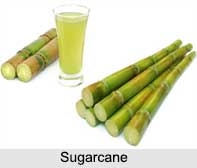 Sugarcane is one of the major crops of India. India is one of the significant producers of sugarcane in the world. Sugarcane is raised in almost every state of India. Over the years, sugar has turned into a substantial ingredient of regular food intake. It is one of the major farming practices amongst Indian farmers. Though, it is highly susceptible to different insects, weeds and many species of nematodes.
Sugarcane is one of the major crops of India. India is one of the significant producers of sugarcane in the world. Sugarcane is raised in almost every state of India. Over the years, sugar has turned into a substantial ingredient of regular food intake. It is one of the major farming practices amongst Indian farmers. Though, it is highly susceptible to different insects, weeds and many species of nematodes.
Types of Sugarcane
An extensive variety of Sugarcane is grown in India and these are as follows:
•Bhima
•Nayana
•Bhavani
•Kalyani
•Uttara
•Sarayu
•Moti
•Dhanush
•Krishna
•Raseeli
•Pramod
•Gandak
•Rajbhog
•Rasbhari
•Shyama
Conditions for Sugarcane Production in India
It is a long duration crop and needs 10 to 15 and even 18 months to mature, depending upon the geographical conditions. It needs hot and moist climate with an average temperature of 21 degree 27 degree and 75-150 centimetres rainfall. In the latter half, temperature above 20 degree centigrade is needed. Irrigation method is required in regions receiving minor rainfall and short cool dry winter season in ripening and harvesting.
Cold weather is harmful to sugarcane, so it has to be harvested before cold season. On the other hand, hot dry winds are also unfavourable to sugarcane. It can grow on a variety of soils including loams, clayey loams, black cotton soils, brown or reddish loams and even laterites. In fact, sugarcane can tolerate any kind of soil that can retain moisture. But deep rich loamy soils are ideal for its growth. The soil should be rich with nitrogen, calcium and phosphorus but it should not be either too acidic or too alkaline. It is a labour intensive cultivation requiring sowing, hoeing, weeding, irrigating, and cutting and so on. The optimum conditions required for the growth and cultivation of cane are found mostly in southern region of India. The cane belt of India is basically situated in the Ganga Plain west of the longitude of Patna and to the north of Yamuna River. This particular belt accounts for more than half of the total cane production in India.
 Sugarcane Production in India
Sugarcane Production in India
India has the largest area under sugarcane cultivation in the world and is world"s second largest producer of sugarcane next to Brazil. The production began looking up again with the establishment of sugar mills in the decade 1971-81. The production of sugarcane reached an all time record in 1999-2000. Uttar Pradesh is a leading producer, followed by Maharashtra, Punjab, Andhra Pradesh, Bihar, Tamil Nadu and Karnataka.
The three distinct belts of sugarcane cultivation can be identified are:
•The "Satluj-Ganga" plain from Punjab to Bihar containing 51 per cent of the total area and 60 per cent of the country"s total production.
•The black soil belt from Maharashtra to Tamil Nadu along the eastern slopes of the Western Ghats.
•Coastal Andhra and the Krishna Valley.
Uses of Sugarcane in India
Sugarcane is mainly used for manufacture "jaggery" (gur) and sugar. It is used for preparation of juice and syrup. Different products like bagasse, molasses, pressmud cake etc. are made from cane and are used for different reasons. Falernum is a sweet and slightly alcoholic drink made from sugarcane juice. Rum liquor is made from sugarcane products.




















